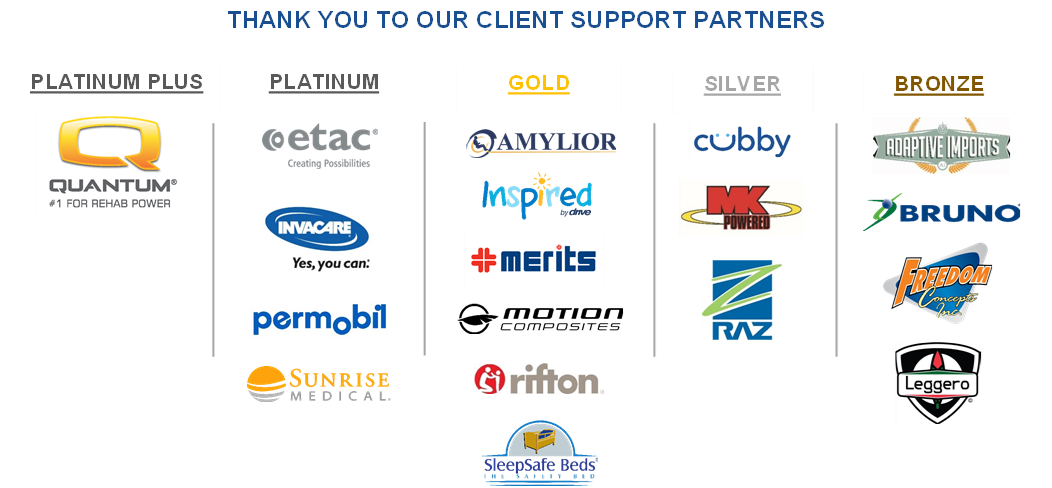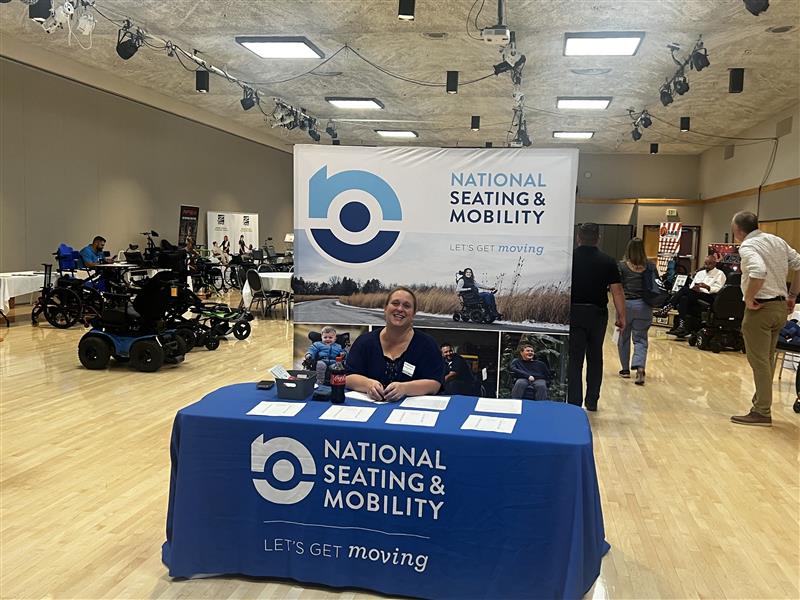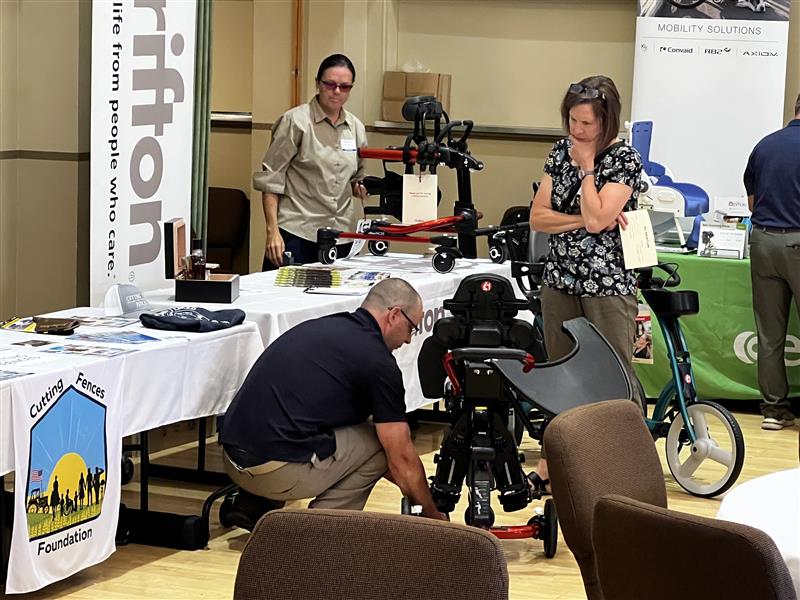BILLINGS MOMENTUM ACADEMY EDUCATION & TECHNOLOGY EXPO
Friday, August 1, 2025
University of Mary - Billings
2590 Holman Ave, Ste A
Billings, MT 59102
Event Highlights
- Earn up to 6 hours of continuing education (CE) credits for PT, PTA, OT, COTA, ATP
- Network with industry professionals
- Exhibit hall with the latest assistive technology
- Breakfast and lunch provided
The rate is: $69 for up to 6 CE credits
HOTEL RECOMMENDATION
Hilton Garden Inn - Billings
(0.5 mile from the University)

2465 Grant Rd, Billings, MT 59102
(406) 655-8800
SCHEDULE OF EVENTS
7:00am - 7:45am: Registration
7:45am - 8:00am: Kick-off
8:00am - 12:00pm: Education Courses
12:00pm - 1:00pm: Lunch
1:00pm - 5:00pm: Education Courses
The Supplier Exhibit Hall will be open throughout
the day with 2 hours of dedicated exhibit hall time.
Click here for full event schedule.
Continuing Education Courses
Custom-Configured Seating - Designing Seating & Mobility for Growing Bodies
0.1 CEUs / Intermediate
Presented by: Amanda Storey, MOT, OTR/L
Etac/Ki Mobility
Custom-configured seating may be perceived by some as a challenging puzzle. With all the possible configurations and myriad shapes, components, and materials to select from or define, how does one determine what to do? Understanding the clinical decision-making as well as the purposes and capabilities of this seating technology can profoundly influence successful outcomes. It can be a challenge to get it right, but it is called complex rehab, after all.
In this presentation, we will briefly review the relevant components of a postural assessment. We will then discuss how to translate the findings from that assessment to specify and design the custom-configured seating system and accurately work our way through and complete the order form. Considerations will include providing an understanding of the variety of custom modifications, planning for growth or other changes, and ensuring an appropriate integration with a mobility base.
Evidence-Driven MWC Configuration: Optimizing Fit and Function for Different Body Types and Propulsion Methods
0.1 CEU / Intermediate
Presented by: Ashley Detterbeck DPT, ATP/SMS
Permobil
This 1-hour course is designed to help providers and clinicians develop best practices for recommending complex rehab technology (CRT) manual wheelchairs for individuals with varying body proportions and propulsion styles. Using the ICF model, the course will guide participants through the decision-making process, balancing evidence with functional outcomes to ensure successful CRT seating and wheeled mobility solutions. Through case examples and clinical reasoning discussions, participants will learn to identify clients' individual clinical and functional goals, driving configuration and component recommendations that enhance functional mobility outcomes, participation, and overall satisfaction with the equipment, ensuring a good person-technology match.
Pediatric Wheelchair Cushions and Backs - Matching Technology and Needs
0.1 CEU / Intermediate
Presented by: Amanda Storey, MOT, OTR/L
Etac/Ki Mobility
For many years, there were only a couple basic choices of primary supports for pediatric wheelchair users: custom configured or custom molded. The available options for primary supports, backrests and cushions, for the pediatric client have expanded considerably over the years, and today there are a number of off-the-shelf, out-of-the-package products available. This greater range of available products requires professionals to be more discerning regarding the variety of choices before them, and recognize which product accomplishes the objective in a clinically appropriate way. We know that children are not just a smaller version of the adult client and that their needs can be different. What does the research say about what is important for the pediatric client regarding providing postural support, addressing postural asymmetries, maintaining tissue integrity, facilitating function, etc. This presentation will explore the types of primary supports on the market, and seek to inform clinical practice by discussing considerations and applications of the various types of technology for primary supports for the pediatric wheelchair user.
Tailored Seating Solutions for High-Risk Clients
0.1 CEU / Beginner
Presented by: Ashley Detterbeck DPT, ATP/SMS
Permobil
In the wheelchair seating arena, providing a seating system for the clients at high risk for pressure injury can be both intimidating and overwhelming. This 1-hr course provides an in-depth understanding of how to incorporate evaluation findings, seating characteristics, and client goals when formulating equipment recommendations for high-risk clients. Participants will learn to identify clinical indicators of pressure injury risk, apply ISO wheelchair cushion performance standards, and recognize key material traits in seating products. A complex case example will be discussed to illustrate the process of integrating evidence and client goals to enhance functional independence.
By the end of this course, participants will be equipped with the knowledge to make informed, evidence-based, and client-centered seating recommendations, ultimately improving the quality of life for wheelchair users.
Prescriptive Planning - Turning Chaos Into (an) Order
0.1 CEUs /
Presented by: Amanda Storey, MOT, OTR/L
Etac/Ki Mobility
Every wheelchair fitting starts with a good eval, from client history to equipment trials, to careful measurements (and let’s not forget to get the rider’s and caregivers’ thoughts on what matters to them). Once we have funding, we do our delivery and fitting and we’re done with that rider for the next 5 years, right? We know that’s not the case at all. Riders change. Whether it’s growth, weight changes, changes in the rider’s condition, or evolution of wheelchair skills, riders change. Can the chair you prescribed change with them?
In this session, we are going to look at a variety of the decisions that you often face when configuring a chair and help navigate some of options that will allow you to build future adjustments into the chair. We will discuss some of the more critical adjustments to consider, and what their impact can be on present and future performance. We will also discuss some of the set-up factors you need to consider when fitting and adjusting your chair and will offer some tips on how to avoid some of the mistakes that can rob a chair of its efficiency and performance.
Pediatric Adaptive Standing: Five Considerations for Optimizing the Outcomes
0.1 CEU / Intermediate
Presented by: Allison Weissman, PT, DPT
Rifton
This 60-minute presentation will address five novel and up-to-date considerations for pediatric adaptive standing. Specifically: standing as physical activity, positioning for postural control, hip abduction positioning and contracture management, active participation in the sit-to-stand transfer, and creating opportunities for social engagement and participation in standing. Current evidence supporting these interventions will be presented along with case examples to illustrate applications of these concepts. A segment for Q&A will conclude the session.
Center of Gravity: Understanding the Functional Impact
0.1 CEU / Beginner
Presented by: Petra Conaway, PT, DPT, ATP
Motion Composites
Define and examine center of gravity as it relates to manual wheelchair configuration. Review evidence related to configuration and optimal manual wheelchair performance.
Explore the impact of vertical and horizontal axle position changes on end user function, safety, and upper extremity health.
The Case for Wheels: An Overview for Selecting the Clinically Appropriate Power WC Base
0.1 CEU / Beginner
Presented by: Jennifer Janowicz PT, DPT
Quantum Rehab
The recommendation of power wheelchair mobility can be very challenging within the Complex Rehab market these days. There are many different choices for the consumer to choose from. Drive wheel configuration choice can have a major impact on how the wheelchair is utilized and how the power wheelchair functions for the individual. This class will provide the participant with an overview of the information they will need to assist in the selection of the correct power base for the individual’s specific needs.
Beyond the Base: The Seating Professionals Responsibility of Educating on Manual Wheelchair Components
0.1 CEU / Intermediate
Presented by: Petra Conaway, PT, DPT, ATP
Motion Composites
When configuring an ultralight manual wheelchair, significant time and consideration is spent on the base. Accessories are necessities of the seating system to complete the configuration. As professionals, we must educate clients and caregivers on the advantages and disadvantages of each selected component, creating an understanding of how components contribute to overall function and satisfaction.
Dialing It In: Drive Wheel Configuration and the Impact on Programming Alternative Drive Controls
0.1 CEU / Intermediate to Advanced
Presented by: Jennifer Janowicz PT, DPT
Quantum Rehab
Control of a power wheelchair with a proportional control vs an alternative switched control is very different and should be treated as such. To make things more challenging adding in different drive wheel configurations and personal preference complicates it further. This course will review drive wheel configuration and programming parameters and how to integrate both together to optimize the consumer’s experience. To drive this point home there will be a driving experience for a limited number of participants to conclude the class.
Changes with Age: Giving You the Justification for Custom Manual Wheelchairs for the Geriatric Client
0.1 CEU /
Presented by: Petra Conaway, PT, DPT, ATP
Motion Composites
The geriatric client can be easily overlooked as one who could benefit from a custom fitting, ultralightweight, adjustable manual wheelchair. They are too often provided the “basic” wheelchair without much thought. This course with review normal physiological changes that come with aging, and how proper wheelchair seating, base selection, fitting, and set up, can be justified for the geriatric client.
Balancing Function and Independence: Clinical Considerations for Power Adjustable Seat Height and Anterior Tilt
0.1 CEU / Beginner
Presented by: Jennifer Janowicz PT, DPT
Quantum Rehab
Power wheelchairs are designed to augment function when functional mobility is compromised or lost. However, this is not the only benefits that the power mobility systems can provide. There are critical components of this system that also facilitate or improve the end user’s ability to complete functional activities/ADLs, support their physical and mental health, provide independent repositioning for pressure relief, increase tolerance of the seated position, and increase the overall satisfaction of the equipment. These critical components are known as power positioning devices. While there are several different types of power positioning products on the market, this presentation will focus on the clinical benefits of power adjustable seat height and anterior tilt.
This session identifies some seating and positioning principles and equipment configurations which can enhance functional control and lead to successful mobility outcomes for self-mobility. Some aspects of the Pediatric Power Wheelchair Screening Test will be discussed.
Explore the course offerings. You can pick & choose the classes you'd like to attend during registration.





